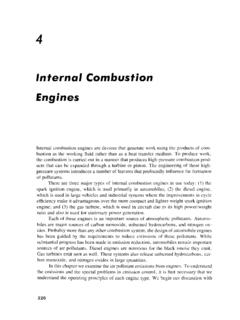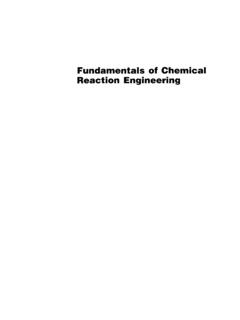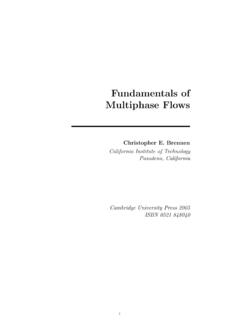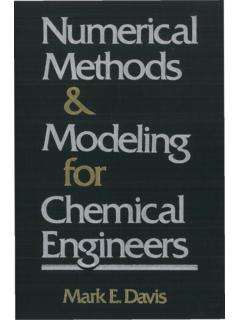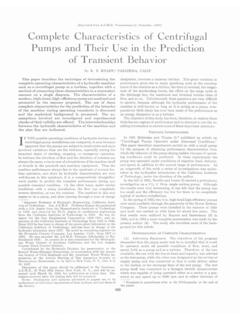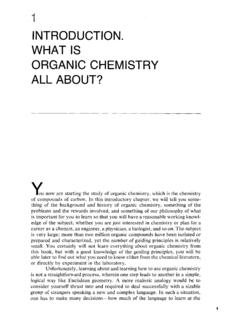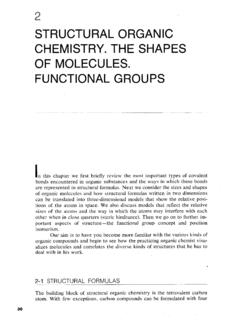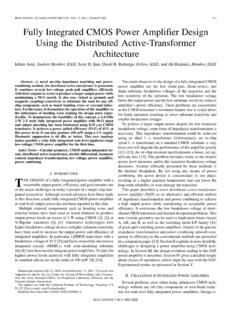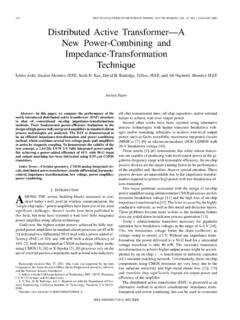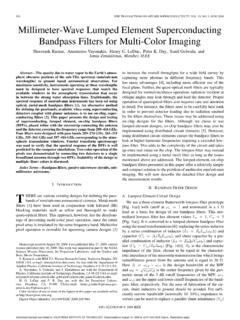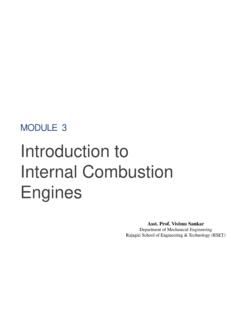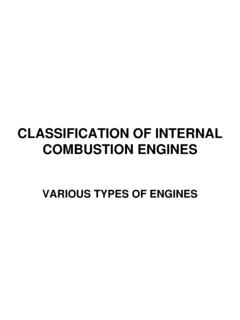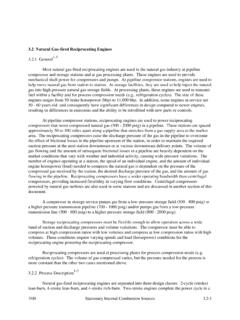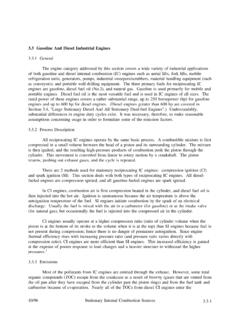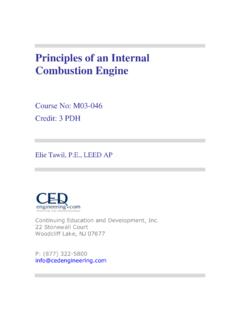Transcription of Internal Combustion Engines
1 4 InternalCombustionEnginesInternalcombust ionenginesaredevicesthatgenerateworkusin gtheproductsofcom-bustionastheworkingflu idratherthanasa ,thecombustionis carriedoutina mannerthatproduceshigh-pressurecombustio nprod-uctsthatcanbeexpandedthrougha introducesa :(1)thesparkignitionengine,whichisusedpr imarilyinautomobiles;(2)thedieselengine, whichisusedinlargevehiclesandindustrials ystemswheretheimprovementsincycleefficie ncymakeitadvantageousoverthemorecompacta ndlighter-weightsparkignitionengine;and( 3)thegasturbine, ,unburnedhydrocarbons, , , ,car-bonmonoxide, , pistonmovesupanddownina cylinder,transmittingitsmotionthrougha (topdeadcenter)B=crankanglePistonPistonr odCrankB=180 (bottomdeadcenter) ; ; ;stroke4, ,thesparkplugisfired, burningmixtureexpands, , ,highpowerisneededanda , , , 'I-,~0' ~ (f) "brakespecificfuelconsumption." ' ' , ,a ,however, , ,producingthenoisereferredtoasknock(Byet al.,1981).Onecharacteristicofthefuelcomp ositionisitstendencytoautoignite, , ,V".
2 , ,( )Theefficiencyoftheengineisa simplefunctionofthecrankangle,(),andther atioofthelengthofthepistonrodtothatofthe crank,thatis,Vd(lV=Ve+ -1+- -cos()-2c( )wherelisthepistonrodlengthandc ()=0 ,commonlyreferredtoastopdeadcenter, ,BOC,()= (rpm) , , , ,however, ,wecanassumethatinanyonecycletheengineop eratesatconstantspeed,load, discussionofthethennodynamicsofthesparki gnitionenginecycleanddevelopa flowsthrougha carburetorandvaporizesbeforeit , , , ,thisexpan-sionrequiresthatotherelements offluid,bothburnedandunburned, result,theburningelementoffluiddoesworko ntheotherfluidinthecylinder,oW=pdV, , ,thepropagationrateforsmallpres-suredist urbancesisthespeedofsound,a,=.JyRT/M( ) 'Yistheratioofspecificheats,cilcu'andMis themolecularweightofthegas;asisoftheorde rof500to1000m cylinder10cmindiameter,thetimerequiredfo ra ,considerablyshorterthanthetimerequired ,toa firstapproximation,wemayassumethatthepre ssureis uniformthroughoutthecylinderatanyinstant oftime, "zero-dimensional"thermodynamicmodel(Lav oieetaI.))
3 ,1970;BlumbergandKummer,1971).Thismodeld escribesthethermodynamicstatesoftheburne dandunburnedgasesasa functionoftime, controlvolumeenclosingallthegasesin! ,];.Similarly,massmayleavethroughtheexha ustvalveandpossiblythroughleaksata flowrate];,.Thefirstlawofthermodynamics( )forthiscontrolvolumemaybewritteninthege neralformdU----dQdWd1=];hi-];.h"+d1-dtwh ereUisthetotalinternalenergyofthegasesco ntainedinthecylinderandh;andhearethemass specificenthalpiesoftheincomingandexitin gflows, ,W,isthatofapressureactingthrougha ~aus~valveandassumethatnoleaksoccur,noma ssentersorleavesthecylinder( ,];=Ie=0).Theenergyequationthensimplifie stod_dQdVdt(muT)=d1-PdtwhereUTisthetotal massspecificinternalenergy(includingener giesofformationofallspeciesinthecylinder ),-Qisheattransferredoutofthecharge, , ,thetimederivationsmaybeexpressedasdd- =w-dtdewherewistheenginerotationspeed(cr ankangledegreespers).ThuswehaveddQdVde(m uT)=de-pde( ) ,witha massfraction(Xofburnedgas,( )where< ) uniformintemperature( ,<uu)=u, ,a fluidelementbums, , , "((X,(X')representtheenergywhenthecombus tionhasprogressedtoburnedgasmassfraction (Xofa fluidelementthatburnedwhentheburnedgasma ssfractionwas(x'.)))
4 Averagingoverallburnedgas,wefind( )Theinternalenergyofeitherburnedorunburn edgasmaybeexpressedintermsofthespecifich eat,TUi=Llul(To)+L)c,'j(T')dT'( )Whilethespecificheatsvarywithtemperatur e,wehavealreadyseeninChapter2 thatvariationissmallovera , ,T,::::;T::::;T2,thisaveragebecomes( )Theinternalenergiesoftheburnedandunburn edportionsofthegasmaybeex-pressedinterms oftheaveragespecificheatsby( ) ( ), (Ci.,Ci.')is thetemperatureofanelementthatburnedatCi. 'ata ,( )whereSubstitutionof( ),( ),and( )intotheenergyequationyieldsd__dQdVde[m( 1-Ci.)(all+CI,"T,,)+mCi.(ab+Clb(TI, )]=de-pde( )Thetotalvolumeofburnedandunburnedgasesm ust,atalltimes,equalthevol-umeinthecylin der:( )( )( )Assumingidealgaseswithconstantcompositi on,themeanspecificvolumeoftheburnedgasis (_)~(XRbTil(Ci.,Ci.')IRb(Th)Vh= "'--'--""-'-oPPNotingthatRh=("Ib-1)Cl'b, where"Ib=Cph/Cl'histheratioofspecifichea ts,( )maynowbesimplifiedto_pV"Ib-1 ,h(Th)=----m(l-Ci.)---cl'uT""Ih-1"Iu-1 Substitutingthisresultinto( )eliminatestheburnedgastemperaturefromth eenergyequation:~lm(l-Ci.))
5 Au+m(l-Ci.)(~)~~U)Cl,JUpVJdQdV+ +---=de-p-e"Ih-1d( ) ,thecylinderisassumedtobefilledwitha ,cylindervolume,andgastemperatureattheti metheintakevalveclosesarePi'Vi'andTi, (atleastcomparedtothatbetweencombustionp roductsandthewall), ,thepressureinthecylindercanbedetermined fromtheformulafortherelationbetweenpress ureandvolumesinadiabaticcompression,rVT" p(O)=PilV(~)J( )Thetemperatureoftheunburnedgasthroughou tthecycleisthatdetern1inedbyadiabaticcom pressionSubstituting( )into( )anddifferentiatingyield()(-"("-1)/'1,,1 1Im(1 -a)Y"-YucT -~cpYb-1"11'PiP"IudOI()(Yu-I)/1"jdY"-Yu_ Pa+ma"-au-_C,'UTi--YiJ1Pi_dOPdVVdp+----+ ----YiJ-1dOYb-1dOdQdV=dO-PdO( )( )Thisequationmayberearrangedtoexpressthe rateofchangeofthecylinderpressureintern1 Softheconditionsattheendoftheintakestrok e,therateofvolumechange,andthecombustion andheattransferrates,thatis,QI()(-"(,,-I )/"YU'JIdYiJdVYb-YII-T ca-----P--ma"-au-C,'uidpdOYb-1dOYiJ-1 PidOdO_)--;Y"-YuYII-ITi(p)(-"(U-1l/'l"Vm (1a(,'u--+---Y"-1"IIIPPiYiJ-1( ) ,da/dO,tousethemodelof( ).))))
6 Toefficientlyconverttheheatreleasedbycom bustiontoworkonthepiston, ,sothecombustioncantakeatmosta ,tensofmilli-secondswouldberequiredforla minarflamepropagationacrossa ,therefore, ,theturbulentflamespeeddependsontheturbu lentintensity,u'.Theturbulentintensityis governedbyensinedesignandoperation, ratethatdependsoncombustionkineticsthrou ghthelaminarflamespeed, , ,therefore, complex, ,theflowseparates,re-sultingina highlyunsteadymotion(HoultandWong,1980). , ,theturbulencemaybecharacterizedintermso ftwoquantities:(I)theturbulentkineticene rgyperunitmass+u~)( )( )whichdescribesthelarge-scalebehavioroft heturbulence,and(2)therateofturbulentkin eticenergydissipationc=1J1~~1~11-1ax! ax!whichdecribestheeffectsofthe velocitythatisprop0l1ionaitothepistonspe edandhencetotheangularrotationspeed, , ,areusedtocreatea , ,therateofchangeofthetur-bulentkineticen ergyisa balancebetweenproductionanddissipation:p cdE,p---=pPdtwherePistherateofturbulentk ineticenergyproduction.( ) ,head, toberelatedtouIforhomogeneous,isotropict urbulence,whereAandIaretheTaylormicrosca leandintegralscale, ( )Assumingthatangularmomentumintheturbule ntfieldisconservedduringtherapidcompress ion:weseethatEisproportionaltoEL( ) ,p}3= ( ),thisyieldsor( )( )( )( ) ,theproductionofturbulentkineticenergyis muchmorerapidthanitsdissipation(Borgnakk eetal.
7 ,1980),dEkpP"",p-dtandapplying( ),theproductionofturbulentkineticenergyd uetotherapiddistortionoftheturbulentfiel dduringcompression,yields2 EkdpP"'"---3 PdtTherateequationforEkbecomesdEk2 Ekdpdt3 PdtCE~( )whereEhasbeeneliminatedusing( ).Theproductiontermgenerallydominatesdur ingthecompressionandcombustionprocessesd uetotherapidchangeindensity,so( )mayberewrittenas( ) ,(J,is,toa firstapproximation,independentofthecrank rotationspeed, ( ) ,fora givenenginegeometry,thevalueofu'atanycra nkangle,(J,isapproximatelyproportionalto theangularspeedUo~wandtheturbulentflamep ropagationvelocityincreaseswiththeengine speed.( ) ,ifex(0)isknownforoneenginespeed, ,therefore,weshallsimplyspecifya functionalfonnforex(0)thatexhibitstheess entialfeaturesofactualcombustionprofiles ,thatis,a delayfromthetimethesparkisfireduntilthep ressureriseassociatedwithcombustionbecom esappreciable,anac-celeratingcombustionr ateuntila largefractionofthechargeisburned, ,( )where00isthecrankangleatwhichthesparkis firedandL.)
8 0, , , ( )withex(O)givenby( ) functionoftheturbulentfield(Borgnakkeeta I.,1980).Forourpresentpurposes,itissuffi cienttoassumethattheengineisadiabatic( ,dQ/dO=0).Oncethepressureinthecylinderis knownthemeanburnedandunburnedgastemperat urescanbecalculatedusing( )and( ), isassumedthatnomixingoftheburnedgasesocc ursandthatheattransferfroma , massfractionburnedwasex'is( )Thetemperatureoftheelementimmediatelyfo llowingcombustion,T"(ex',ex'),maybeevalu atedbyapplyingthefirstlawofthennodynamic stothecombustionofaninfinitesimalmassofc harge, sufficientlysmallincrementalmass,thepres surechangeduringcombustionis ,thatis,--h"=U"+R"J:,=h"=Ub+R"T" becomes( )From( ), ( ),and( ) (1976)foranenginewitha firedat40 ,t::dl"is60 . ,thepressureinthecylinderrises, ,cylinderpressure,andtemperaturesofthega sthatbumsearly,Teolate,T,andthemeangaste mperatureinsidethecylinder(afterHey-wood ,1976). workdoneona ,moreworkisdoneonthegasthatbumsearlyinth ecyclethanisdoneonthatthatbumsata ,therefore, wesawthatNOformationishighlytemperatured ependent,soweexpectthattheNOformationrat ewillvarywithlocationinthecharge, , :+1N2+0"<'):NO+N-I+ 2N+O2E)INO+ 0-2t3N+OH("):NO+H-3 Assumingthat0,OH,andHareattheirequilibri umconcentrationandthatNatomsareatpseudo- steadystate,weobtainedthefollowingrateeq uationforNOfor-mationanddecomposition( ):( )whereYNO=molefractionofNO(3=YNO/YNO"fra ctionalattainmentofequilibrium*YNO.
9 =equilibriummolefractionofNOR;=forwardre actionrateofreactionievaluatedatequilibr iumconditions,i=1,2,3 When(3<1 anddYNo/dO>0,NOtendstoform;when(3>1 anddYNo/dO<0, ( )isintegratedateachpointa'inthechargefromthecrankangleatwhichthatelementinitiallybumstoa *Weuse~ " )lNO=i~YNOJa')da'( )Nitricoxideconcentrationsversuscrankangle,computedbyBlumbergandKum-mer(1971), ,a'=0, , ,asthefirstelementcoolsduringexpansion,therateofNOdecompositionrapidlydecreases,sothatafterabout40crankangledegrees, ~LastelementOverallNO~~",,~,~~Last"!~~element,"'~~Middle'"..~ ::.:::Equivalenceratio= BTDCto30 \/"IIIIIIIIIII/200060004000800010, functionofcrankangleforthefirst,middle,andlastelementtobumfor1>= (BlumbergandKummer,1971). , ,thetemperaturesofthedifferentburnedelem entsdropsharply,"freezing"theNO( ,thechemicalre-actionsthatwouldremovethe NObecomemuchslower)atthelevelsformedduri ngcombustion, , , ,greaterthan1%.Workdonebythe ,thepressureinthecylinderis ,workisdonebythe gasremaininginthecylinder, , , it wasshownthatCOoxidationproceedsprimarily byreactionwithOH,CO+OHE~CO2+ ,whereinitwasshownthattherateofCOoxidati onisdirectlycoupledtotheratesofthethree- bodyrecombinationreactions,primarily,H+O 2+ME~H02+ (1975)usedtherate-constrained, partial-equilibriummodel(basedondirectmi nimizationoftheGibbsfreeenergy) , ,however; , ,Ct,andthemassfractionthathasleftthecyli nderwhentheelementleavesthecylinder, , = '\,\\\\\\/\COe",,,'\,\,,','\',',z= ,\",,,'.
10 'I'I~Iz= 'z= +=u~'+-Q)oEouoTDC306090512015010t(ms) , 'isthemass fractionburnedandzisthefractionofthegast hathasleftthecylinderduringtheexhaustpro cess(Heywood,1975). ,butagreementisgoodnearstoichiometric(He ywood,1976).Infuel-richcombustion,theCOl evelsintheexhaustgasesareclosetotheequil ibriumconcentrations, , , <cf> < ,thefuelandairarepremixed, ,insteady-flowcombustionsystems, ,then,arerelativelylargequantitiesofhydrocarbongasespresentinthecombustionproductsofautomobileengines?Thisques-tionhasbeenthesubjectofnumerousinvestigationsinwhichhypotheseshavebeendevelopedandsupportedwiththeoryandexperiment, ,DanielandWentworth(1962)magnifiedphotographsoftheflamespreadinthecylinderofa ,thesmallvolumebetweenthepistonandcylinderwallabovethetoppistonring,calledthecrevicevolume, (Tabaczynskieta!.,1972; SAE,Inc.). smallfractionofthetotalgasinthecylinderina normallyoperatingengine, , ,butonthewholethemorecompletelyburnedgasesatthecenterofthechamberarepreferentiallyex-haustedfirst, (1962), , , (1972)furtherobservedthat,duringtheexpansionstroke, ,thelayerisscrapedoffthewallandrolledupintoa vortex, ,recentstudieshavequestionedtheimportanceofquenchlayersassourcesofunburnedhydrocarbons(LavoieetaI.
